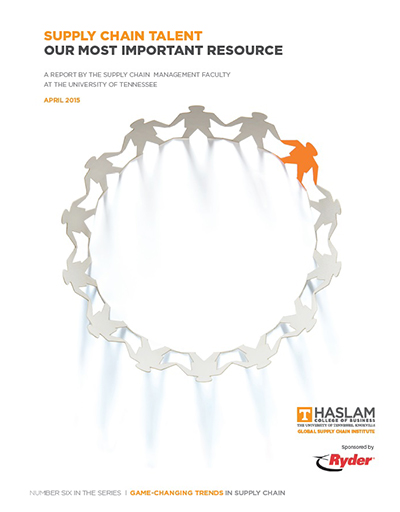Talent Development

Unlocking the Potential of the Gen XYZ Labor Force
Supply Chain Management Best Practices & Strategies for a Changing Workforce
Megatrends and disruptions, like COVID-19, have fundamentally transformed the supply chain landscape. Within this report, experts with UT’s Global Supply Chain Institute explore how companies must frequently adapt by investing in digital tools, redesigning networks, and building agile, resilient capabilities. However, the most urgent challenge is managing the shift in workforce demographics. Namely, as Baby Boomers retire, members of Generations X, Y (“Millennials”), and Z take their place. This white paper provides insights and best practices from top companies on labor force development, recruitment, and retention to position Gen XYZ talent management as a pillar for supply chain excellence.

End to End Supply Chain Synchronization
Best Practices for Orchestrating a Winning Strategy
Successfully executed end to end supply chain strategies drive value by verifying that all supply chain activities, processes, and transitions are synchronized to the core business driver of the benchmark company. Everyone in the organization is on the same page, with supply chain leaders acting as orchestra conductors. However, successful implementation of end to end supply chain synchronization requires several elements for readiness. First and foremost of these is 100% commitment from business leadership. Download this white paper to explore what else you’ll need to build your winning strategy. Includes a toolkit, case study, best practices, benchmarking data, and more.

Diversity and Inclusion in Supply Chain Management
Young Professional Women’s Perspectives on Supply Chain Diversity and Inclusion
More than ever before, supply chain management is center stage. The increased scrutiny and complexities of global supply chains highlights the need for organizations to onboard, develop, and maintain fantastic talent. Research shows that companies with more diverse management teams have 19% higher revenue due to innovation. Yet only 15% of supply chain organizations are led by female executives. This white paper shares the experiences of new female supply chain professionals to illustrate opportunities for supporting women in the workplace. It also provides a framework for building more gender-equitable workplaces.

Supply Chain Best Practices for Building a High Performance Organization (HPO)
Tips for Leaders and Teams
Both early career supply chain professionals and senior supply chain leaders understand that their work is directly linked to company success. People are the heart of the supply chain. So how do you build a high performance organization (HPO) where every member of the supply chain team meets and exceeds their goals? In this paper, we explore supply chain management best practices that answer that question.

Talent Management Best Practices for Supply Chain Professionals
Why Supply Chain Talent Should Be Your Top Priority
Global supply chain organizations are facing an unprecedented talent crisis. Rising complexities increase the demand for skilled professionals while talent supply remains low. With labor shortages across roles—from drivers to executives—organizations are pressured to rethink their talent management strategies. The most successful supply chain professionals view their talent as their most critical asset. Organizations can turn supply chain talent management into a competitive advantage for long-term success by adopting supply chain best practices and addressing key talent challenges.